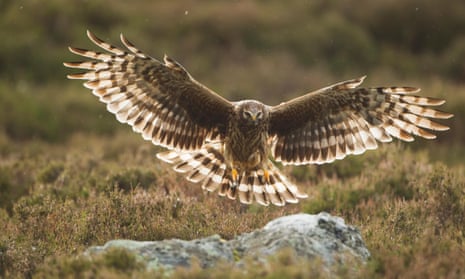Landowners, shooters, gamekeepers and conservationists have backed a long-delayed government plan to resolve a deep-rooted conflict over England’s most threatened bird of prey.
The fate of the hen harrier in the English uplands has been of serious concern following years of illegal persecution by gamekeepers who have used poisoned bait to protect the grouse-shooting interests of landowners.
In 2015 there were just six nests in England with 18 fledglings, mostly on the Lancashire heather moorlands. There are around 600 breeding pairs in Scotland and 50 in Wales.
The new hen harrier action plan - that has taken traditionally opposing groups more than four years to agree - brings together several countryside groups and government bodies and acknowledges officially that harriers in England are on the brink of extinction because of persecution.
It hopes to build up populations using six initiatives, including satellite and CCTV monitoring, nest protection, the reintroduction of birds to suitable lowland areas and encouraging them not to feed on game birds. In addition, it would involve police wildlife crime units and volunteers to monitor populations.
Most of the actions agreed by the different groups have already been trialled successfully. The most contentious is likely to be a trial of “brood management”. This would involve moving birds’ eggs or broods to rearing pens away from moorland when harrier numbers increase above an agreed density. Young birds would be reared until they fledge, whereupon they would rejoin the wild population.
“There is absolutely no lethal control involved. During the trial, young harriers would be fitted with satellite tags to measure movements and survival. If the trial scheme is successful, it would be available as an ongoing tool for grouse moors to conserve hen harriers, to be used under licence from Natural England,” says the action plan.
Each of the six actions recommended have been costed over five years, with the total is expected to be more than £1.5m.
“This new plan will transform the fate of one of our most magnificent birds. Our wildlife is a crucial part of our national identity. That’s why we care deeply about protecting this vital species for future generations to come,” said Rory Stewart, the environment department’s undersecretary of state.
“I welcome this plan - not because it is perfect, it isn’t - but because it reflects real potential for progress on one of the most deep-rooted conflicts in conservation. We needed action. The prize is that the landowners are now part of the conversation. The test will be if we succeed in getting the hen harrier flying again over upland England. This is progress,” said Martin Harper, director of the RSPB.
“We believe the plan will go a long way to resolving one of the most divisive issues in upland conservation and help bring together all those who care deeply about the future of the uplands. We have always been clear that for any plan to be successful it must address the causes of illegal persecution, as well as tackling persecution itself,” said Tim Bonner, chief executive of the Countryside Alliance.
“Whilst there was never any excuse for illegal killing the proposals for brood management, which has been used successfully for the reintroduction of other species such as the red kite and sea eagle, removes real concerns about the impact of colonies of hen harriers on grouse moors,” he said.

Comments (…)
Sign in or create your Guardian account to join the discussion